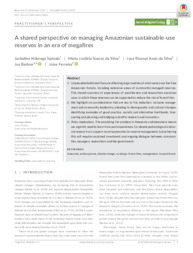A shared perspective on managing Amazonian sustainable-use reserves in an era of megafires.
A shared perspective on managing Amazonian sustainable-use reserves in an era of megafires.
Author(s): SPÍNOLA, J. N.; SILVA, M. J. S. da; SILVA, J. R. A. da; BARLOW, J.; FERREIRA, J. N.
Summary: Unprecedented forest fires are affecting large swathes of what were once fire‐free Amazonian forests, including extensive areas of community‐managed reserves. This shared overview of experiences of practitioners and researchers examines ways in which these reserves can be supported to reduce the risk of forest fires. We highlight six considerations that are key to fire reduction: inclusive management and community leadership, adapting to demographic and cultural changes, identifying examples of good practice, socially just alternative livelihoods, forecasting and planning and bridging scientific research and innovation. Policy implications. The escalating fire problem in Amazonia and elsewhere means we urgently need to learn from past experiences. Co‐developed ecological and social research can support novel approaches to reserve management, but achieving this will require sustained investment and ongoing dialogue between communities, managers, researchers and the government.
Publication year: 2020
Types of publication: Journal article
Unit: Embrapa Eastern Amazon
Observation
Some of Embrapa's publications are published as ePub files. To read them, use or download one of the following free software options to your computer or mobile device. Android: Google Play Books; IOS: iBooks; Windows and Linux: Calibre.
Access other publications
Access the Agricultural Research Database (BDPA) to consult Embrapa's full library collection and records.
Visit Embrapa Bookstore to purchase books and other publications sold by Embrapa.

